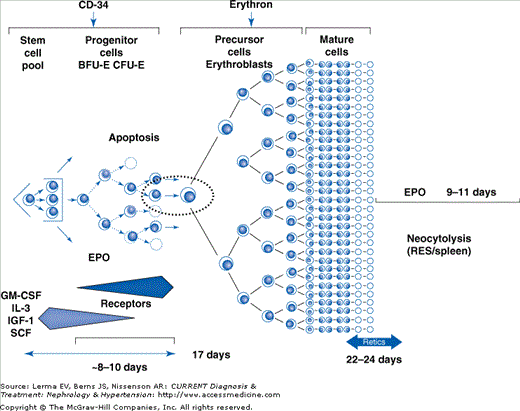Essentials of Diagnosis
General Considerations
Since the initial observations by Richard Bright in 1836 on the relationship of anemia to renal inefficiency, anemia has remained as an ever-present comorbidity of progressive chronic kidney disease (CKD). The Kidney Disease Outcomes Quality Initiatives (K/DOQI) clinical practice guidelines for chronic kidney disease first published in 2002 helped focus attention on chronic kidney disease and its comorbidities, specifically anemia.
Recent data support the direct relationship of anemia to cardiovascular disease and to patient mortality in end-stage renal disease (ESRD). Anemia of CKD is generally caused by the inability of the kidneys to produce significant quantities of erythropoietin, but other factors are frequently involved including decreased red blood cell survival and iron deficiency. Despite the clinical introduction of recombinant human erythropoietin (rHuEPO) in 1989, there is still an estimated 1.5 million individuals with anemia in the United States. Additionally, anemia (hemoglobin <12 mg/dL) is present in greater than 75% of dialysis patients.
The availability of rHuEPO revolutionized our understanding of uremia and quickly became a major tool in the armamentarium of nephrologists to improve symptoms previously thought to be due to the “uremic syndrome.” Correction of anemia in these patients resulted in an improved sense of well being, improved energy levels, a significant improvement in sleep disturbances, improved cognitive function, and an improvement in the ability to perform tasks of daily living. More significantly, improved hemoglobin levels in CKD patients have been correlated with decreased left ventricular hypertrophy (LVH) and improved cardiovascular outcomes.
Although debate continues on the proper “target” hemoglobin, the days of accepting hemoglobins less than the K/DOQI guideline recommended of 11–12 g have passed. Clinical research identifying cardiovascular events as a leading cause of mortality in CKD, ESRD, and transplant patients has made a critical understanding of the management of anemia essential to the practice of nephrology.
Pathogenesis
Under normal homeostatic conditions, the kidney very precisely regulates plasma volume through the reabsorption or excretion of salt and water. Hemoglobin levels are maintained in response to the production of erythropoietin to tissue hypoxia.
Erythropoietin is known to be a multifunctional tropic factor with effects on not only the bone marrow but on the central nervous system where studies have shown both neurotrophic and neuroprotective functions. Its primary target although is the pluripotent hematopoietic stem cells of the bone marrow. This cell line is capable of forming erythrocytes, leukocytes, and megakaryocytes. Erythropoietin is produced by specialized fibroblasts in the interstitium of the kidney in response to hypoxia (Figure 18–1).
Figure 18–1.
Erythropoiesis is divided into two stages. Erythropoietin (EPO) is needed in the first stage (from multipotential to progenitor cells in the burst-forming unit erythroid) but not in the second precursor cell stage. The site of action of EPO and other growth factors is shown. Dashed circles indicate potential apoptosis of progenitor cells. (Adapted with permission from Erslev AJ et al: Erythropoietin in the pathogenesis of the anemia of chronic renal failure. Ersler AJ et al: Kidney Int 1997;51:623.)
As renal function declines, anemia becomes more common. The majority of patients with a GFR less than 60 mL/minute/1.73 m2 (K/DOQI stage 3) have insufficient erythropoietin production to maintain hemoglobin >12 g/dL. This results in the typical normochromatic normocytic anemia present in CKD and ESRD. However, anemia of CKD often has etiologies other than insufficient erythropoietin levels.
Treatment
Prior to the clinical introduction of cloned erythropoietin (rHuEPO) in 1989, the world of nephrology was very different. There was no focus on CKD, little focus on treating anemia, but considerable focus on improving the adequacy of dialysis (delivered amount of dialysis). The continued evolution of dialysis equipment including volumetric dialysis machines and dialyzer membrane biocompatibility with improvement of uremic symptoms was of paramount importance. Our ability to more accurately measure the amount of delivered dialysis added to these endeavors.
Anemia was managed in two ways: Severe anemia with hemoglobins less than 8 g/dL was treated with blood transfusions. Less critical management of anemia, viewed as “maintenance management,” involved the use of anabolic steroids. Iron deficiency was rarely a problem; indeed, iron overload from frequent blood transfusions was a much greater problem occasionally resulting in secondary hemachromatosis.
The introduction of erythropoietin and the correction of anemia resulted in the elimination of many symptoms previously thought to be due to uremia. The avid production of new red blood cells consumed the additional iron stores and secondary hemachromatosis soon became a historical footnote along with the use of steroids and their inherent side effects.










